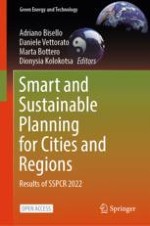The European Union has placed great emphasis on reducing CO
2 emissions in cities and related systems. Cities account for more than 50% of the global population, 80% of the global GDP, two-thirds of global energy consumption and more than 70% of annual global carbon emissions (IEA
2020). These factors are expected to increase significantly in the coming decades: it is anticipated that by 2050 more than 70% of the world’s population will live in cities, resulting in massive growth in demand for urban energy infrastructure (European Commission
2023). Climate action in cities is essential to achieve the ambitious net-zero emissions goals. From this perspective, it is known that urban development in the coming years will have to shift from simple building solutions to positive-energy neighbourhoods and districts (Becchio et al.
2020). All of this, along with other innovative concepts developed in the past for cities of the future, will be key to achieving Europe's energy and climate change goals (Suppa et al.
2022). With the new Horizon Europe research and innovation plan (which will cover the period 2021–2027), Europe is aiming to vigorously address a number of global challenges that affect our cities and society: health and safety, digitization, energy and climate change in the first place (Guarino et al.
2022). With this in mind, PEDs fall under this heading. The area of Smart Cities and Communities was already defined as a priority and strategic by both the previous European Horizon 2020 program and the 17 Sustainable Development Goals established by the UN and the 2030 Agenda (Kroll et al.
2019). Over time, however, it became apparent that financing large smart city projects at the urban level was a complex task, with a huge demand for resources and investment. For this reason, the authors decided to focus efforts on smaller urban areas, such as city blocks, pilot districts and neighbourhoods, towards a concept of a diffused smart land focusing initially on energy efficiency in buildings and on-site local renewable energy production. In recent years, to sustain the urban energy transition, the concept became even more ambitious, from highly efficient buildings to net-zero ones. Later on, by including energy sharing, waste heat recovery, e-mobility and energy storage, the scope was broadened to include the implementation of net-zero districts or even better PEDs (Guarino et al.
2022). PEDs represent a new approach towards a sustainable and efficient city and urbanization model. An urban Positive Energy District combines the built environment, mobility, sustainable production and consumption to increase energy efficiency and decrease greenhouse gas emissions and to create added value for citizens. Positive Energy Districts also require integration between buildings, users and various energy networks, mobility services and IT systems.
